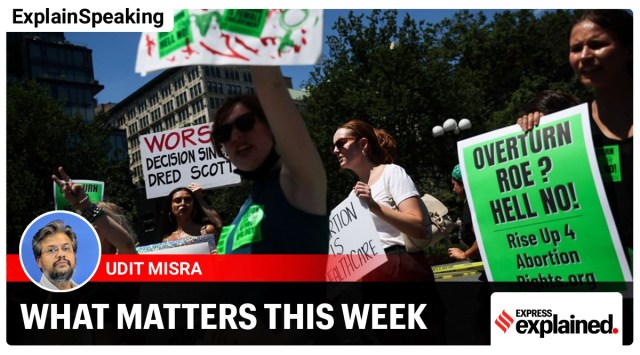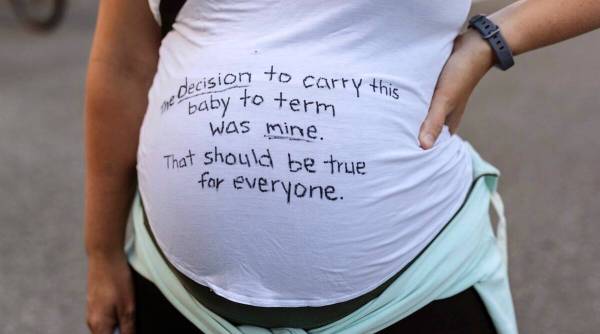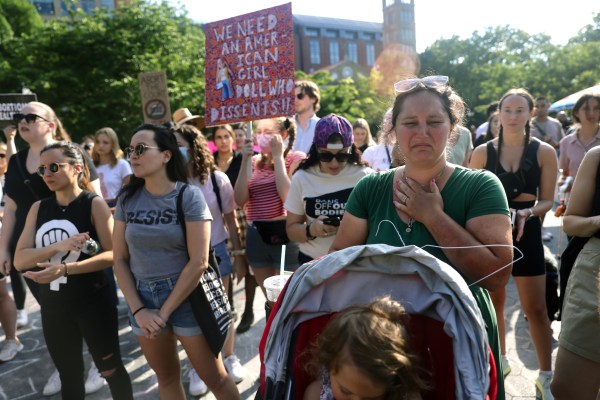- India
- International
ExplainSpeaking: The economics of abortions
In overturning Roe v Wade, the US Supreme Court might have ruled along sharply divided ideological (political, religious and constitutional) lines, yet there is overwhelming academic evidence to suggest that the 1973 ruling had positively impacted both the society and the economy.
 Activists gather to protest against the overturning Roe v Wade. (Reuters)
Activists gather to protest against the overturning Roe v Wade. (Reuters)Dear Readers,
Last week, the US Supreme Court took away the constitutional right to have an abortion. It did so while ruling on another, called “Dobbs v Jackson Women’s Health Organization” which hinged on the constitutionality of a 2018 Mississippi (which is a state in the US) law that prohibits women from having abortions after 15 weeks of pregnancy.
The 15 weeks deadline was critical to the whole issue as it was lower than the 22-23 week benchmark, which is often considered to be the timeframe after which a foetus is viable, or capable of surviving outside the womb.
 The US Supreme Court decided, on June 24, to overturn a half-century-old right to abortion, granted by a 1973 Supreme Court decision in the Roe vs Wade case. (Source: AP)
The US Supreme Court decided, on June 24, to overturn a half-century-old right to abortion, granted by a 1973 Supreme Court decision in the Roe vs Wade case. (Source: AP)
In “Roe v Wade” (1973), the SC had allowed abortions until 28 weeks while this limit was reduced to foetal viability (which, with advancements in medicine, has turned out to be 22 weeks) in another case called “Planned Parenthood v Casey” (1992).
In effect, the SC overruled both “Roe” and “Casey” verdicts.

Oddly enough, the issue of abortion was not terribly political when in 1973 when the SC first ruled in favour of allowing it in “Roe”. But over the years, it has become increasingly politicised. In fact, “Roe” has been overturned primarily because the current SC in the US is dominated by “conservative” justices as against liberal ones.
Legalised abortion is an already complex issue made even more complicated when seen through the emotive lens of religious and societal dogmas as well as political opportunism.
 Abortion rights activists gather to protest in Manhattan on Friday, June 24, 2022. (Jeenah Moon/The New York Times)
Abortion rights activists gather to protest in Manhattan on Friday, June 24, 2022. (Jeenah Moon/The New York Times)
“We end this opinion where we began. Abortion presents a profound moral question. The Constitution does not prohibit the citizens of each State from regulating or prohibiting abortion. Roe and Casey arrogated that authority. We now overrule those decisions and return that authority to the people and their elected representatives,” stated the SC order.
This week’s ExplainSpeaking looks at the economic impacts of “Roe” (which allowed women in the US to have abortions).
A detour
In 2005, authors Steven D. Levitt and Stephen J. Dubner took the world by storm with their book titled “Freakonomics”. They start their book by telling the bizarre story of crime rates in the US. Be it carjacking or crack dealing, robbery, rape or murders, the crime graph in the US was skyrocketing by the early 1990s. In 1995, “the criminologist James Alan Fox wrote a report for the U.S. attorney general that grimly detailed the coming spike in murders by teenagers,” they state. There was so much crime and that too committed by the teenagers that President Clinton reportedly stated: “We know we’ve got about six years to turn this juvenile crime thing around or our country is going to be living with chaos. And my successors will not be giving speeches about the wonderful opportunities of the global economy; they’ll be trying to keep body and soul together for people on the streets of these cities.”
But then, instead of going up, the crime started going down, and so sharply that by 2000 all kinds of crimes from murders to thefts fell to almost 3-4 decade lows. Some rationalised this inexplicable turn of events by pointing toward a booming economy. Others credited tighter gun laws. Others still believed that policing strategies had improved.
 Protestors gather at the The Water Works at Buffalo Bayou Park ahead of a protest against the decision by the US Supreme Court to overturn Roe v Wade, June 24, 2022, in Houston. (Marie D. De Jesús/Houston Chronicle via AP)
Protestors gather at the The Water Works at Buffalo Bayou Park ahead of a protest against the decision by the US Supreme Court to overturn Roe v Wade, June 24, 2022, in Houston. (Marie D. De Jesús/Houston Chronicle via AP)
But Levitt and Dubner revealed a shocking answer: “Perhaps the most dramatic effect of legalized abortion, however, and one that would take years to reveal itself, was its impact on crime. In the early 1990s, just as the first cohort of children born after Roe v. Wade was hitting its late teen years—the years during which young men enter their criminal prime—the rate of crime began to fall. What this cohort was missing, of course, were the children who stood the greatest chance of becoming criminals. And the crime rate continued to fall as an entire generation came of age minus the children whose mothers had not wanted to bring a child into the world. Legalized abortion led to less unwantedness; unwantedness leads to high crime; legalized abortion, therefore, led to less crime.”
The point is that regardless of where one stands on abortions, the Roe verdict did seem to have a huge impact on something as far-fetched as the crime rate.
But this leads to two questions:
1> Is this a case of mere correlation, and not causality?
2> What are the other socio-economic effects of allowing abortions?
Causality, not just correlation
The background research for Freakonomics’ claim was conducted by the lead author Levitt (economics professor at the University of Chicago) and John Donohue (law professor, Stanford University). Donohue is one of the 154 economists who argued in favour of upholding Roe during the Dobbs case. According to a report in The Wall Street Journal (WSJ), Donohue doubled down on his findings. “Now that we have 20 years of data, it is a highly statistically significant finding,” said Prof. Donohue in the WSJ story.
Frankly, when it comes to the ability of economists to ascertain the difference between correlation and causality, much has changed since 1973 or even 1992.
In fact, last year’s Nobel Prize in Economics was awarded to three economists precisely for this advancement. Read this explained piece to know more. One of the 2021 winners, Joshua D Angrist of MIT, is responsible for one of the most often quoted abortion research.
The fact that a handful of states — namely Alaska, California, Hawaii, New York and Washington — had liberalised abortions in 1970, three years before the 1973 ruling, provided a “natural experiment” for economists such as Angrist to study the impact.
Several studies, both before and after Angrist’s work looked at this issue, and more often than not they have come up with more and more robust and significant findings in favour of how abortions positively impacted the status of women.
As far as the causal impact of Roe (or legalising abortions) is concerned, the brief of Amici Curiae economists (154 of them) in support of Roe provides a huge amount of information. There are other sources too such as this review of evidence compiled by the Institute of Women’s Policy Research.
Impact of Roe on birth rates
According to a 1999 study, “Roe v Wade and American Fertility”, by Phillip B. Levine et al., the legalisation of abortion alone—independent of other factors such as contraception—reduced birth rates by 4% to 11%.
Impact on young women and Black women
While the birth-rate reduction caused by abortion legalisation helped women, studies reveal that two groups—young women and Black women—benefitted the most.
“For young women, the estimated reduction in birth rates due to abortion legalization was three times as much as that of all women. Legalization of abortion, together with policies specifically granting young women the ability to obtain an abortion without parental consent, reduced teen motherhood by 34% and reduced teen marriage by 20%,” states the brief
Studies also found that for Black women, the estimated reduction in the birth rate was two to three times greater than the reduction for white women. Further, Black women also experienced a 28 to 40% decline in maternal mortality due to legalisation.
Impacts on women’s social and economic lives
Angrists’ study found “a 22 to 24 percentage point increase in the probability that Black teenage women graduated high school and a 23 to 27 percentage point increase in their probability of attending college”. Studies also show that abortion legalisation had large effects on women’s education, labour force participation, occupations, and earnings. These effects were particularly strong among Black women.
“For instance, one such study showed that young women who utilized legal abortion to delay an unplanned start to motherhood by just one year realized an 11% increase in hourly wages later in their careers. Another found that, for young women who experienced an unintended pregnancy, access to abortion increased the probability they finished college by nearly 20 percentage points, and the probability that they entered a professional occupation by nearly 40 percentage points,” stated the economists before the SC. Again, these effects tended to be greater among Black women.
Studies have also explored long-run downstream effects as the children of the Roe era grew into adulthood. One such study found that as these children became adults, they had higher rates of college graduation, lower rates of single parenthood, and lower rates of welfare receipt. Another showed that abortion legalisation in the 1970s continued to reduce births to unwed teen women in the early 1990s.
What about evidence outside the US?
While all these findings are from the US, the international evidence is also along similar lines.
According to the review by the Institute of Women’s Policy Research: “Many findings from other country contexts are similar to those from the United States: higher educational attainment among women with increased abortion access, worse outcomes for children as a result of restricted abortion access, and lower women’s labor market participation with increased fertility.”
What’s likely to happen now that Roe has been overturned?
In their submission before the SC, the 154 economists supporting Roe had pointed to some glaring facts.
One, “studies show that up to the point of parenthood, men’s and women’s earnings evolve similarly. But as parents, their earnings diverge sharply: mothers experience an immediate and persistent one-third drop in expected earnings while fathers’ earnings remain largely unaffected.”
Inability to get an abortion will create a drag on the economic prospects of women in the US.
Two, “approximately 49% of women who seek abortions are poor, 75% are low income, 59% already have children, and 55% report a recent disruptive life event such as the death of a close friend or family member, job loss, the termination of a relationship with a partner, or overdue rent or mortgage obligations.” In other words, the ban on abortions is likely to hit those women who are already worse off.
To get a glimpse of what could happen to women when abortion is denied, many economists point to the so-called “Turnaway Study”.
The Turnaway Study is a longitudinal study that focuses on financial outcomes for women who cannot obtain an abortion they wanted to have. It compares women who arrived at abortion facilities just prior to a gestational age cut-off and were able to obtain an abortion—the “near-limit group”—to women who arrived just past this cut-off and were turned away— the “turnaway group.”
The study found that “exactly at the point in their lives where one group obtained an abortion and the other group was turned away, the turnaway group began to experience substantial financial distress relative to the near-limit group, such that over the subsequent five years, the average woman in the turnaway group experienced a 78% increase in past-due debt and an 81% increase in public records related to bankruptcies, evictions, and court judgments”.
The study finds that “the financial effects of being denied an abortion are thus as large or larger than those of being evicted, losing health insurance, being hospitalized, or being exposed to flooding due to a hurricane.”
The abortion issue is quite complex because different people tend to decide on it for very different reasons. The test, of course, is to be consistent in one’s thinking.
Share your views and queries at udit.misra@expressindia.com
Stay safe,
Udit
More Explained
EXPRESS OPINION
Apr 16: Latest News
- 01
- 02
- 03
- 04
- 05









































